Groundwater Extraction-Induced Land Subsidence in Decheng District: Evolution Law and Sustainable Management Strategies
Abstract
1. Introduction
2. Materials and Methods
2.1. Study Area
2.2. Dynamic Monitoring Data
2.3. Methodology
2.3.1. Statistical Analysis of Deformation and Hydrological Data
2.3.2. Implementation of Fluid–Solid Coupling and Governing Equations
- (1)
- Fluid control equation
- (2)
- Porous medium control equation
- (3)
- Darcy’s law (Groundwater flow)
- (4)
- Solid mechanics (Formation deformation)
- (5)
- Porous elasticity (fluid–solid coupling)
3. Results and Discussion
3.1. Response of Land Subsidence to Groundwater Extraction
3.1.1. Variations in Groundwater Extraction
3.1.2. Groundwater Level Response Process
3.1.3. Rate of Land Subsidence
3.2. Prediction Analysis of Land Subsidence Numerical Simulation
3.2.1. Model Conceptualization and Geometry
3.2.2. Deformation Characteristics of Different Aquifers
3.2.3. Impact of Pumping Volume and Well Layout
3.2.4. Model Predictions
3.3. Evolution Law of Land Subsidence
3.4. Inspiration of Land Subsidence to Groundwater Management
4. Conclusions
Author Contributions
Funding
Data Availability Statement
Acknowledgments
Conflicts of Interest
References
- Wang, G. New Preconsolidation Heads Following the Long-Term Hydraulic-Head Decline and Recovery in Houston, Texas. Groundwater 2022, 61, 674–691. [Google Scholar] [CrossRef] [PubMed]
- Raspini, F.; Loupasakis, C.; Rozos, D.; Adam, N.; Moretti, S. Ground subsidence phenomena in the Delta municipality region (Northern Greece): Geotechnical modeling and validation with Persistent Scatterer Interferometry. Int. J. Appl. Earth Obs. Geoinf. 2014, 28, 78–89. [Google Scholar] [CrossRef]
- Du, J.; Zhang, Y.; Luo, Z.; Zhang, C. Prediction of Ground Subsidence Induced by Groundwater Mining Using Three-Dimensional Variable-Parameter Fully Coupled Simulation. Water 2024, 16, 2487. [Google Scholar] [CrossRef]
- Gong, S. Summary of land subsidence research in Shanghai. Shanghai Geol. 2006, 4, 25–29. [Google Scholar]
- Herrera-García, G.; Ezquerro, P.; Tomás, R.; Béjar-Pizarro, M.; López-Vinielles, J.; Rossi, M.; Mateos, R.M.; Carreón-Freyre, D.; Lambert, J.; Teatini, P.; et al. Mapping the global threat of land subsidence. Science 2021, 371, 34–36. [Google Scholar] [CrossRef]
- Zhang, Z.; Lin, Q.; Yan, H.; Zhu, X.; Zhang, X.; Yang, S.; Huang, C.; Shi, Y.; Hu, J.; Li, X.; et al. Ground subsidence monitoring and prediction based on InSAR and CNN-BiGRU-Attention: A case study of Chengdu. Eng. Geol. 2025, 357, 108336. [Google Scholar] [CrossRef]
- He, Q.; Liu, H.; Wei, L.; Zhang, Z. Analysis of the Driving Factors for Land Subsidence in the Northern Anhui Plain: A Case Study of Bozhou City. Water 2025, 17, 1854. [Google Scholar] [CrossRef]
- Hao, R.; Wang, X.; Xu, Y. Analysis of the factors resulting in the acceleration of land subsidence in the central area of Dezhou city, China. Environ. Earth Sci. 2022, 81, 400. [Google Scholar] [CrossRef]
- Jia, C.; Zhang, G.; Wang, J.; Zhang, C. Research on land subsidence induced by groundwater extraction and its engineering application: A case study of Dezhou area, Shandong Province. J. Earth Sci. Environ. 2015, 37, 102–110. (In Chinese) [Google Scholar]
- Zhang, Y.; Li, H.; Shang, T.; Jia, C.; Liang, H.; Yang, Y. Extension theory-based division of land subsidence prone areas in Dezhou using analytic hierarchy process. Shandong Land Resour. 2016, 32, 58–64. (In Chinese) [Google Scholar]
- Zhu, L.; Zhan, J.; Zhang, X.; Zhu, D.; Run, P. Discussion on progress in monitoring and prevention of land subsidence in Dezhou City. J. Geol. Hazards Environ. Preserv. 2020, 31, 26–30. (In Chinese) [Google Scholar]
- Wang, H.; Gong, H.; Chen, B.; Zhou, C.; Yang, Y.; Sun, X. A physics-informed neural network approach to predicting land subsidence-rebound in Dezhou City under different climate scenarios. J. Hydrol. Reg. Stud. 2025, 62, 102773. [Google Scholar] [CrossRef]
- Yu, W.; Cheng, C.; Zhang, Y.; Xue, G. Land subsidence analysis in Dezhou based on time-series SAR. Geomat. Spat. Inf. Technol. 2021, 44, 127–129+132. (In Chinese) [Google Scholar]
- Wang, H.; Gong, H.; Chen, B.; Zhou, C.; Yang, Y.; Sun, X. Research on land subsidence-rebound affected by dualistic water cycle driven by climate change and human activities in Dezhou City, China. J. Hydrol. 2024, 636, 131327. [Google Scholar] [CrossRef]
- Fu, X.; Ge, P.; Chen, M.; Zhu, L.; Wei, L.; Ding, R.; Liu, H.; Liu, F. Time-series InSAR monitoring and analysis of land subsidence in Decheng District, Dezhou City, Shandong Province. Geomat. Inf. Sci. 2024, 49, 118–124. (In Chinese) [Google Scholar]
- Jia, C.; Zhang, S.; Sun, X.; Di, S.; Ding, P. Correlation between groundwater extraction and land subsidence in the Northwest Shandong Plain. China Sci. 2021, 16, 173–180. (In Chinese) [Google Scholar]
- Wei, X.; Yang, G.; Liu, T.; Shao, M.; Ma, Z. Study on the hysteresis between groundwater changes and land subsidence based on GRACE and InSAR data. Nat. Resour. Remote Sens. 2025, 37, 122–130. (In Chinese) [Google Scholar]
- Li, W.; Ding, Y.; Yan, S. Effectiveness and suggestions for groundwater over-exploitation control in Dezhou City. Shandong Water Resour. 2024, 8, 64–65+68. (In Chinese) [Google Scholar]
- Feng, Y.; Wu, Q.; Liu, S. Dynamic chemical evolution of deep groundwater in Dezhou City. Shandong Land Resour. 2019, 35, 51–55. (In Chinese) [Google Scholar]
- Zhao, Y. Research on Land Subsidence Caused by Groundwater Exploitation in Dezhou, Shandong. Master’s Thesis, Jilin University, Changchun, China, 2016. (In Chinese). [Google Scholar]
- Duan, X.; Huang, X.; Liu, S.; Yang, Y. Flow field evolution and water quality dynamics of deep groundwater resources in Decheng District, Shandong Province. J. Hebei Norm. Univ. (Nat. Sci. Ed.) 2020, 44, 539–546. (In Chinese) [Google Scholar]
- Farías, C.A.; Sánchez, M.L.; Bonì, R.; Cigna, F. Statistical and Independent Component Analysis of Sentinel-1 InSAR Time Series to Assess Land Subsidence Trends. Remote Sens. 2024, 16, 4066. [Google Scholar] [CrossRef]
- Fomo, D.; Sato, A.H. Adaptive Segmentation and Statistical Analysis for Multivariate Big Data Forecasting. Big Data Cogn. Comput. 2025, 9, 268. [Google Scholar] [CrossRef]
- Chiang, W.; Kinzelbach, W. 3D Groundwater Modeling with PMWIN-A Simulation System for Modeling Groundwater Flow and Pollution; Springer: Berlin/Heidelberg, Germany, 2003. [Google Scholar]
- Luo, Z.; Liu, J.; Li, L. Three-dimensional fully coupled numerical simulation of groundwater withdrawal and land subsidence in Quaternary unconsolidated sediments. Chin. J. Geotech. Eng. 2008, 30, 193–198. (In Chinese) [Google Scholar]
- Jessen, B.; Vogt, S.; Cudmani, R. Combined study of creep and ageing under deviatoric loading in granular materials. Acta Geotech. 2025, 20, 1831–1845. [Google Scholar] [CrossRef]
- Shu, X.; Wang, Z.; Peng, Y.; Zhou, Z.; Tian, Y. A novel elasto-viscoplastic constitutive model for predicting the embankment settlement on soft structured clay. Comput. Geotech. 2024, 167, 106093. [Google Scholar] [CrossRef]
- Musa, D. Advanced 3D thermo-hydro-mechanical modelling of thermal aperture evolution in enhanced geothermal systems. Energy Convers. Manag. 2025, 342, 120129. [Google Scholar]
- Shi, X.; Wu, J.; Ye, S.; Zhang, Y.; Xue, Y.; Wei, Z.; Li, Q.; Yu, J. Regional land subsidence simulation in Su-Xi-Chang area and Shanghai City, China. Eng. Geol. 2008, 100, 27–42. [Google Scholar] [CrossRef]
- Galloway, D.L.; Burbey, T.J. Review: Regional land subsidence accompanying groundwater extraction. Hydrogeol. J. 2011, 19, 1459–1486. [Google Scholar] [CrossRef]
- Luo, Z.; Wang, X.; Dai, J.; Li, Z.; Li, S. Influence of Land Subsidence on Minable Groundwater Resources. Earth Sci. 2024, 49, 248–252. [Google Scholar]
- Zhou, C.; Gong, H.; Chen, B.; Li, X.; Li, J.; Wang, X.; Gao, M.; Si, Y.; Guo, L.; Shi, M.; et al. Quantifying the contribution of multiple factors to land subsidence in the Beijing Plain, China with machine learning technology. Geomorphology 2019, 335, 48–61. [Google Scholar] [CrossRef]
- Chen, H.; Xue, Y.; Qiu, D. Numerical simulation of the land subsidence induced by groundwater mining. Clust. Comput. 2023, 26, 3647–3656. [Google Scholar] [CrossRef]
- Hong, Y.; Chen, P.; Yao, Y.; Qiu, L.; Liu, H.; Zhu, C.; Lu, J. Land Subsidence in the Loess Plateau: SBAS-InSAR Analysis of Yan’an New District During 2017–2022. Sensors 2025, 25, 6298. [Google Scholar] [CrossRef]
- Hayashi, T.; Tokunaga, T.; Aichi, M.; Shimada, J.; Taniguchi, M. Effects of human activities and urbanization on groundwater environments: An example from the aquifer system of Tokyo and the surrounding area. Sci. Total Environ. 2008, 407, 3165–3172. [Google Scholar] [CrossRef]


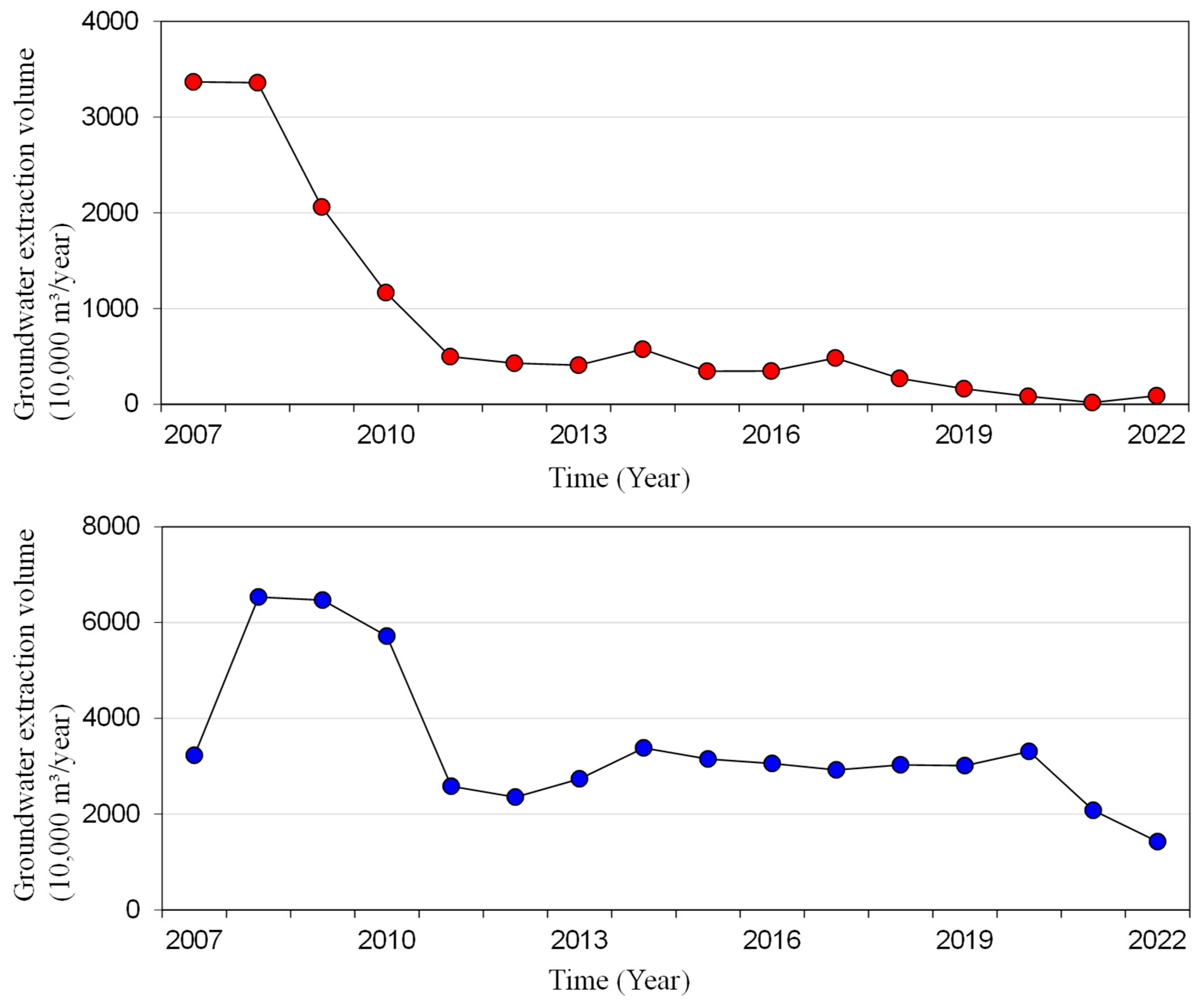
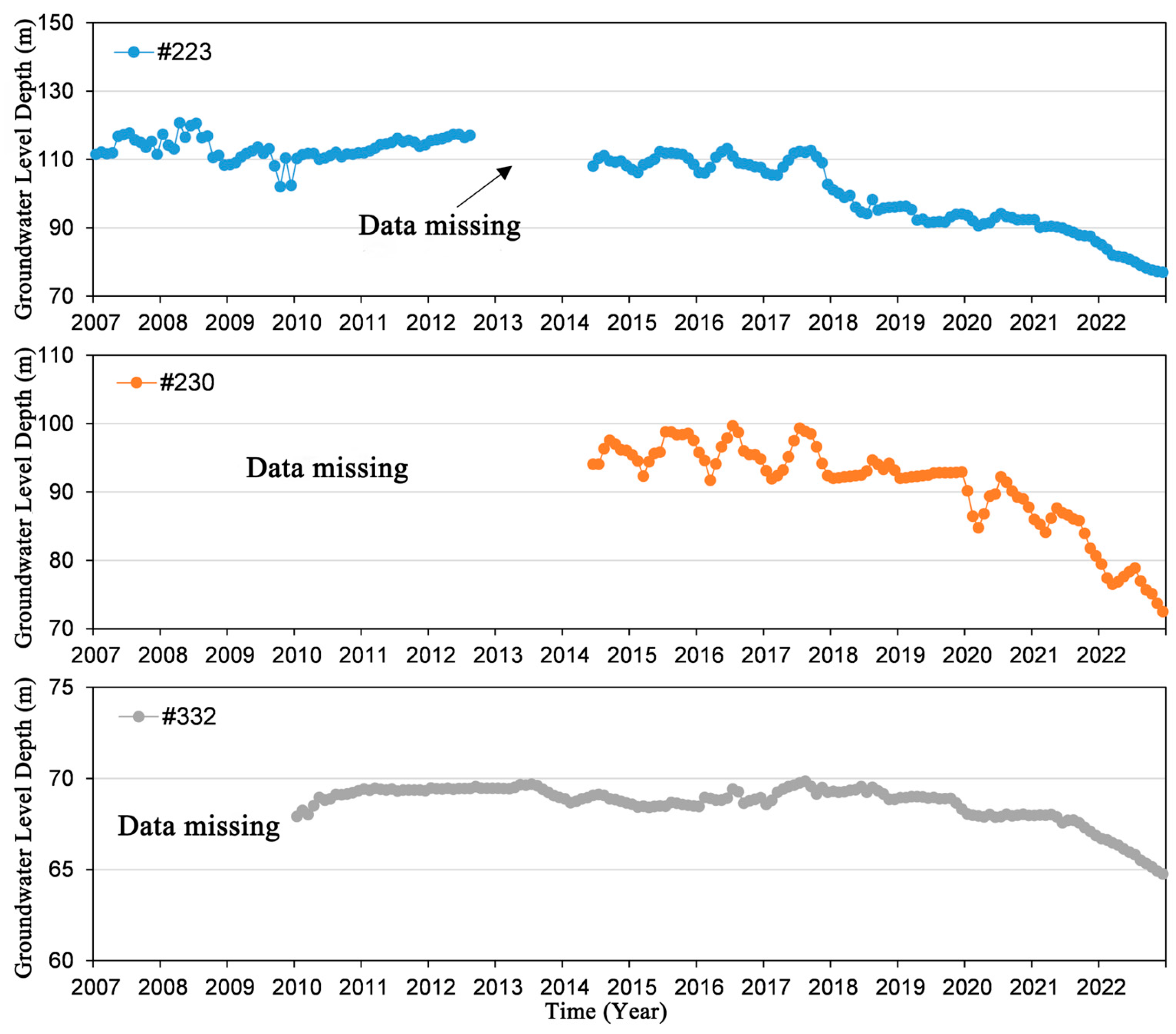






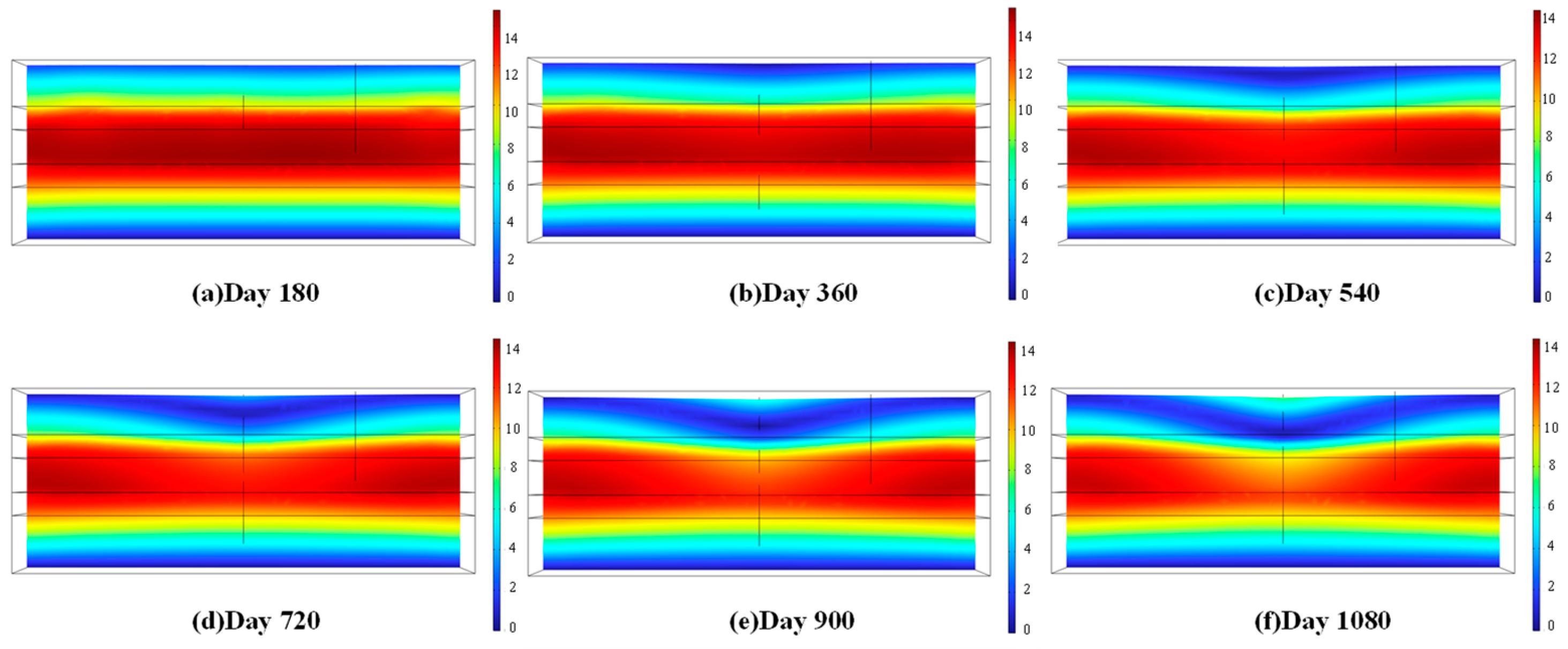



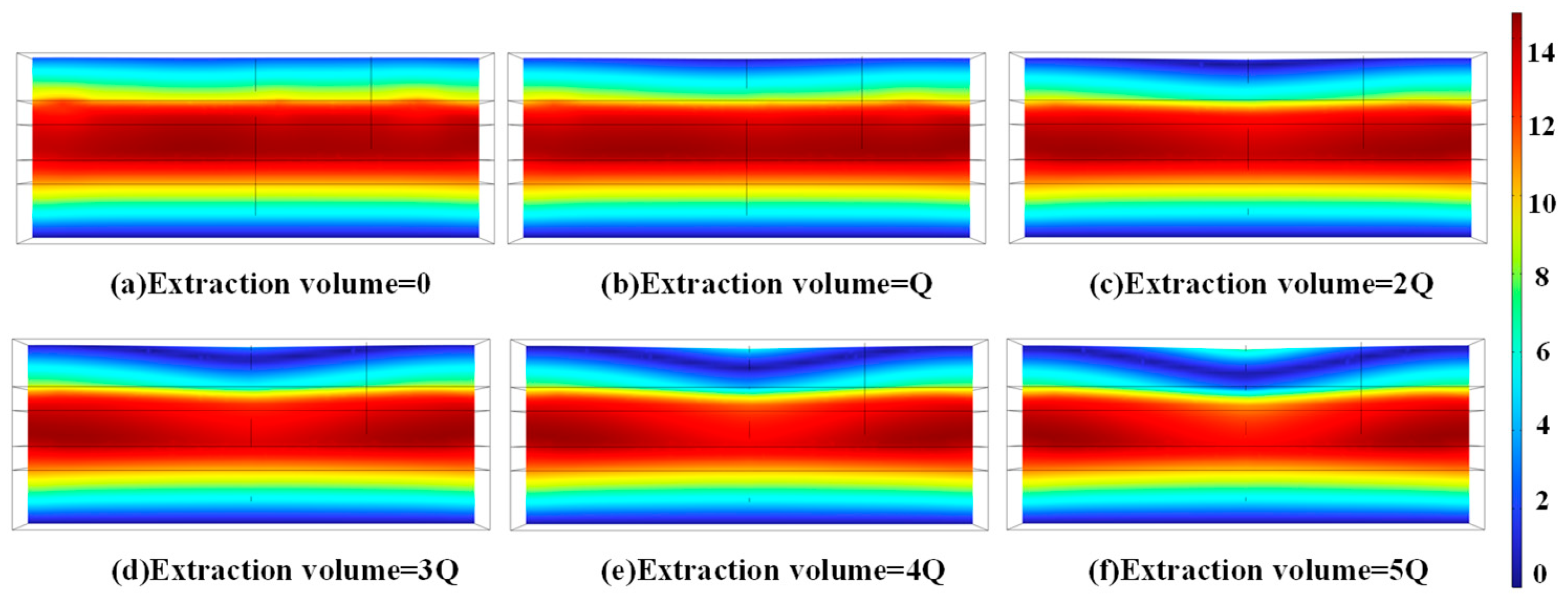
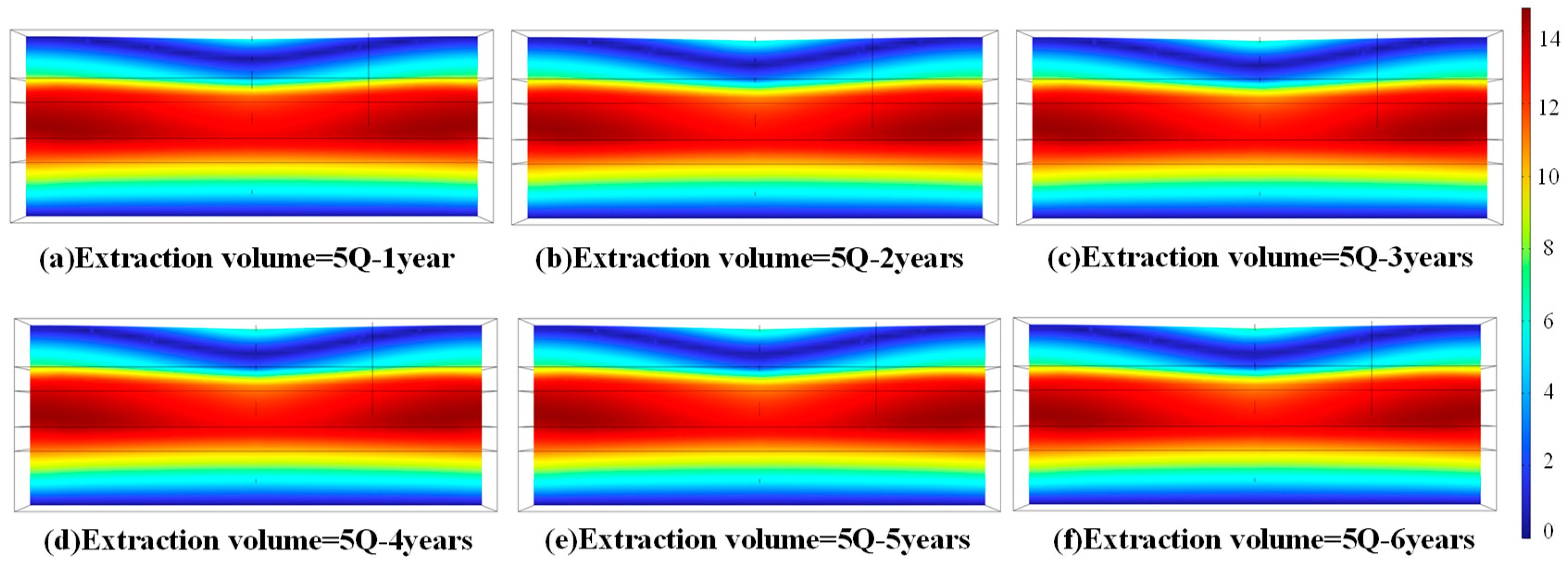


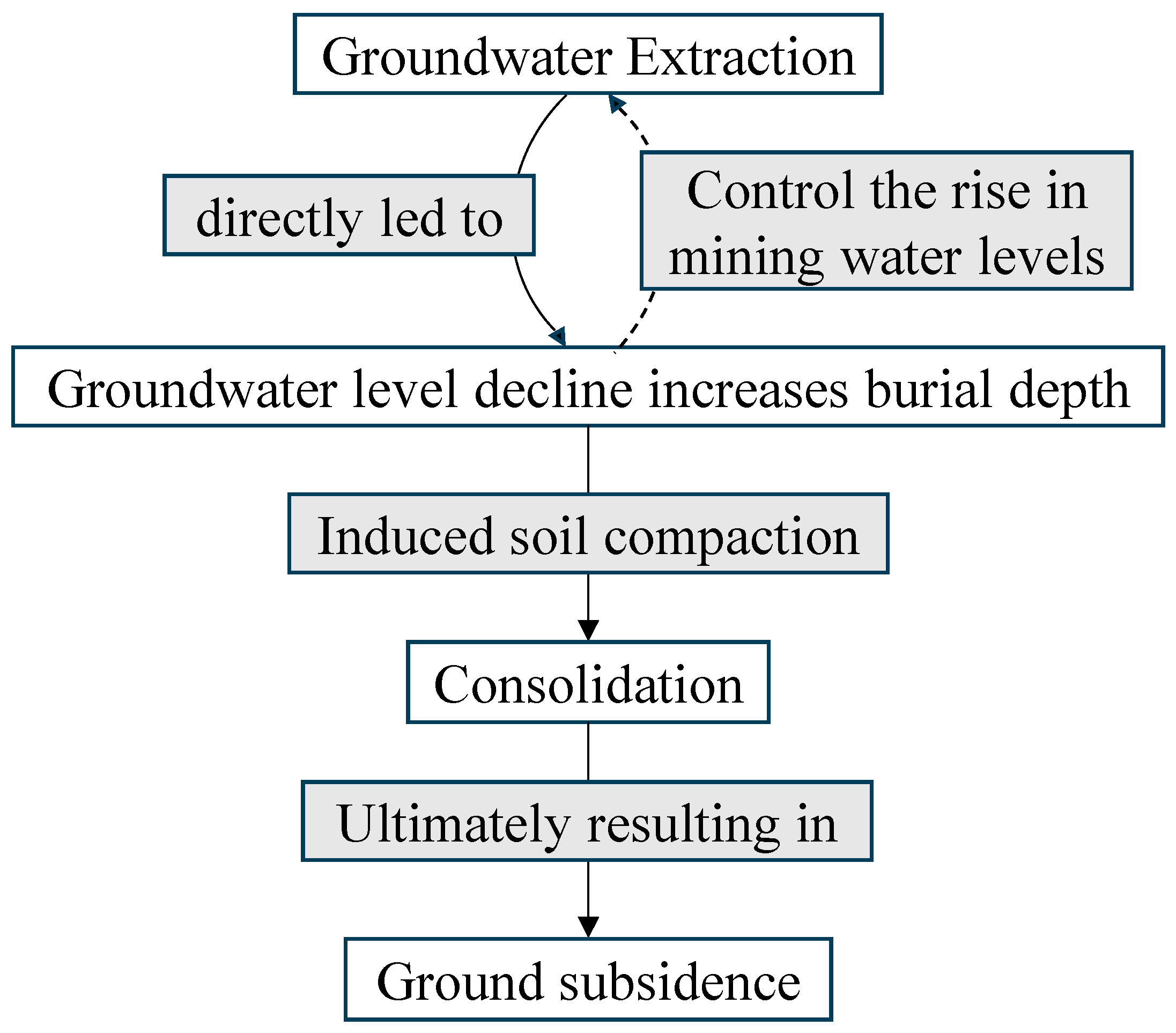
| Direction | Physical Process | Influence Parameters |
|---|---|---|
| seepage→deformation | The decrease in water head changes the effective stress field | Triggering soil strain and displacement |
| deformation→seepage | Soil compression changes pore structure and permeability | coefficient k and porosity n |
| Dot | 2007.9–2010.11 | 2010.11–2021.11 | 2021.11–2022.9 |
|---|---|---|---|
| DJ9 | −55 | −226 | −5 |
| YD9 | −72 | −269 | −15 |
| D9 | −84 | −313 | −10 |
| Q3 | −83 | −312 | −10 |
| Q1 | −96 | −409 | −5 |
| D62 | −106 | −397 | −5 |
| Property/Unit | 0–200 m | 200–300 m | 300–450 m | 450–550 m | 550–800 m |
|---|---|---|---|---|---|
| Density/kg/m3 | 1980 | 2050 | 2100 | 2150 | 2150 |
| Young’s Modulus/Pa | 1.1 × 108 | 5 × 107 | 1.4 × 108 | 6 × 107 | 1.9 × 108 |
| Poisson’s Ratio | 0.35 | 0.3 | 0.25 | 0.25 | 0.2 |
| Dynamic Viscosity | 0.001 | 0.001 | 0.001 | 0.001 | 0.001 |
| Biot Coefficient | 0.8 | 0.7 | 0.75 | 0.6 | 0.8 |
| Porosity | 0.44 | 0.3 | 0.35 | 0.25 | 0.32 |
Disclaimer/Publisher’s Note: The statements, opinions and data contained in all publications are solely those of the individual author(s) and contributor(s) and not of MDPI and/or the editor(s). MDPI and/or the editor(s) disclaim responsibility for any injury to people or property resulting from any ideas, methods, instructions or products referred to in the content. |
© 2025 by the authors. Licensee MDPI, Basel, Switzerland. This article is an open access article distributed under the terms and conditions of the Creative Commons Attribution (CC BY) license (https://creativecommons.org/licenses/by/4.0/).
Share and Cite
Jia, G.; Chuai, Y.; Yan, Y.; Du, J.; Ni, P.; Liang, W.; Zhu, Z.; Lou, K.; Gao, Z.; Liu, J. Groundwater Extraction-Induced Land Subsidence in Decheng District: Evolution Law and Sustainable Management Strategies. Water 2025, 17, 3240. https://doi.org/10.3390/w17223240
Jia G, Chuai Y, Yan Y, Du J, Ni P, Liang W, Zhu Z, Lou K, Gao Z, Liu J. Groundwater Extraction-Induced Land Subsidence in Decheng District: Evolution Law and Sustainable Management Strategies. Water. 2025; 17(22):3240. https://doi.org/10.3390/w17223240
Chicago/Turabian StyleJia, Guangzhong, Yunxiang Chuai, Yan Yan, Jinliang Du, Pingsheng Ni, Wei Liang, Zhiyong Zhu, Kexin Lou, Zongjun Gao, and Jiutan Liu. 2025. "Groundwater Extraction-Induced Land Subsidence in Decheng District: Evolution Law and Sustainable Management Strategies" Water 17, no. 22: 3240. https://doi.org/10.3390/w17223240
APA StyleJia, G., Chuai, Y., Yan, Y., Du, J., Ni, P., Liang, W., Zhu, Z., Lou, K., Gao, Z., & Liu, J. (2025). Groundwater Extraction-Induced Land Subsidence in Decheng District: Evolution Law and Sustainable Management Strategies. Water, 17(22), 3240. https://doi.org/10.3390/w17223240








